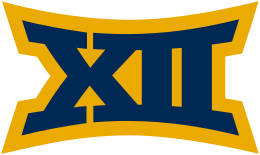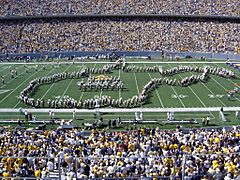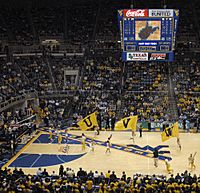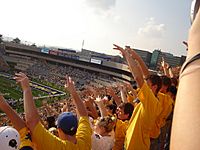West Virginia Mountaineers facts for kids
Quick facts for kids West Virginia Mountaineers |
|
|---|---|
 |
|
| University | West Virginia University |
| Conference | Big 12 MAC Great America Rifle Conference |
| NCAA | Division I (FBS) |
| Athletic director | Shane Lyons |
| Location | Morgantown, West Virginia |
| Varsity teams | 17 |
| Football stadium | Mountaineer Field at Milan Puskar Stadium |
| Basketball arena | WVU Coliseum |
| Baseball stadium | Monongalia County Ballpark |
| Mascot | The Mountaineer |
| Nickname | Mountaineers |
| Fight song | Hail, West Virginia (official) Fight Mountaineers (official) Take Me Home, Country Roads (unofficial) |
| Colors | Old Gold and Blue |
| Men's sports | Women's sports |
|---|---|
| Baseball | Basketball |
| Basketball | Cross country |
| Football | Gymnastics |
| Golf | Rowing |
| Soccer | Soccer |
| Swimming & diving | Swimming & diving |
| Wrestling | Tennis |
| Track & field† | |
| Volleyball | |
| Co-ed sports | |
| Rifle | |
| † – Track and field includes both indoor and outdoor. | |
The West Virginia Mountaineers are the athletic teams that represent West Virginia University, an American university located in Morgantown, West Virginia. The school is a member of National Collegiate Athletic Association Division I. The Mountaineers have been a member of the Big 12 Conference since 2012. At that time, the Mountaineers joined the Mid-American Conference as an affiliate member for men's soccer. The two major sports at the university are football (played at Mountaineer Field at Milan Puskar Stadium) and basketball (played at the WVU Coliseum), although many of the other sports have large followings as well.
Currently, WVU sponsors seven men's sports, ten women's sports, and one coeducational sport (rifle). Men's golf was the latest sport to be added in the 2015–16 school year.
Contents
Championships
NCAA team championships
West Virginia has won 20 NCAA team national championships.
- Men's (1)
- Boxing (1): 1938 (unofficial)
- Co-ed (19)
- Rifle (19): 1983, 1984, 1986, 1988, 1989, 1990, 1991, 1992, 1993, 1995, 1996, 1997, 1998, 2009, 2013, 2014, 2015, 2016, 2017
See also:
- Big 12 Conference National team titles
- List of NCAA schools with the most NCAA Division I championships
Other national team championships
Below are 5 national team titles that were not bestowed by the NCAA:
- Men's basketball (1): 1942
- Rifle (4): 1913, 1961, 1964, 1966
See also:
- Pre-NCAA Rifle Championships
- List of NCAA schools with the most Division I national championships
Cross country
- Head Coach: Sean Cleary
- World Cross Country Qualifiers: 11
- BIG EAST Conference Champions: 2007
- NCAA Regional Champions: 2004,2008
- NCAA Appearances: 9
- NCAA Top 10 finishes: 5: 2007,2008,2009,2011,2014
- NCAA Elite 8 finishes: 4: 2008,2009,2011,2014
- NCAA Final 4 finishes: 1: 2008
- Highest NCAA Finish: 4th
- Last NCAA Appearance: 2014
- All-Americans: 15
- Elite 89 Winners: Ahna Lewis-2009, Kelly Williams 2014
NACAC Campions, Metcalfe, Grandt, Harrison NACAC Silver Medallists: Asselin, Forsey,
- National Team Members: World Cross Country Team Members 10, NACAC Championships Team Members 9
Gymnastics
- Competition Facility: WVU Coliseum (14,000)
- Head Coach: Jason Butts
- Most Victories: 26 in 1992
- NCAA Tournament Appearances: 3 (under former head coach Linda Burdette)
- AIAW Appearances: 1
- Last NCAA Appearance: 2000
- All-Americans: 4
Rifle
For rifle, a sport in which fewer than 40 NCAA member schools participate, the Mountaineers are a member of the single-sport Great America Rifle Conference and have won the most NCAA Rifle Championships of any school at 18.
- Playing Facility: WVU Shell Building
- Head Coach: Jon Hammond
- Most Victories: 19 in 1964
- NCAA Appearances: 26
- NCAA Team Championships: 18
- NCAA Team Runner up: 7
- National Individual Champions: 21
- NCAA All-Americans: 65
- Olympians: 13
- Gold Medal: Virginia "Ginny" Thrasher - Rio 2016
- Awards: CaptainU Coach of the Year
Women's track
- Playing Facility: Mountaineer Track, Shell Indoor Track
- Head Coach: Sean Cleary 2007-Present
- Assistants: Shellyann Galimore Erin Oreilly
- Olympians: 4
- NCAA National Champions: 3, Pat Itanyi Long Jump 1994, Kate Vermeulen 1999 Mile, Megan Metcalf 5000 2005,
- NCAA Runner Up Finishes: Marie Louise Asselin 2011-5000, Kate Harrison 10,000 2012
- NCAA All-Americans: 31
NCAA Top 10 Finishes: 1 2010 Outdoors NCAA Sweet 16 Finishes: 1999, 2010, 2011 NCAA top 20 Finishes: 1999, 2009 2010,2011,
NCAA Division I: NACDA Learfield Director's Cup
- See footnote and NACDA Directors' Cup
| WVU Directors' Cup Standings | ||||||||||||||||||||||||||||||||||||||||||||||||||||||||||||||||||||
|---|---|---|---|---|---|---|---|---|---|---|---|---|---|---|---|---|---|---|---|---|---|---|---|---|---|---|---|---|---|---|---|---|---|---|---|---|---|---|---|---|---|---|---|---|---|---|---|---|---|---|---|---|---|---|---|---|---|---|---|---|---|---|---|---|---|---|---|---|
|
|
|
||||||||||||||||||||||||||||||||||||||||||||||||||||||||||||||||||
Sports traditions
Firing of the Musket
The Mountaineer mascot carries a period Musket and powder horn for firing a shot to signal the opening of several athletic events. The Mountaineer points the gun into the air with one arm and fires a blank shot, a signal to the crowd to begin cheering at home football and basketball games. The Mountaineer also fires the musket every time the team scores during football games.
Formation of the State
The Pride of West Virginia forms the outline of the state of West Virginia during the pregame show of all home Mountaineer football games. The outline of the state moves down the field during the playing of "Hail West Virginia", and the shape inverts to face the student side of the stadium when the crowd begins the "Let's Go...Mountaineers" chant.
Cheers
The "Let's Go...Mountaineers" cheer originated at home football games as a competition between opposite sides of the stadium. The student side of the stadium chants "Let's Go...", and the pressbox side responds "Mountaineers". The chant can continue for long periods of time, as each side of the stadium tries to keep the chant from fading. The cheer has spread to other athletic events including basketball and soccer.
The "WVU First Down" cheer is used when fans are expecting a first down call during a football game. Prior to the announcement, fans put their arms in the air and yell while waiting for the call. After the announcement, the fans lower and raise their arms three times while simultaneously yelling the initials "WVU". Then, the fans clap and signal to the end zone while cheering "first down!"
Carpet roll
In 1955, Fred Schaus and Alex Mumford devised the idea of rolling out an elaborate gold and blue carpet for Mountaineer basketball players to use when taking the court for pre-game warm-ups. In addition, Mountaineer players warmed up with a special gold and blue basketball. The university continued this tradition until the late 1960s when it died out, but former Mountaineer player Gale Catlett reintroduced the carpet when he returned to West Virginia University in 1978 as head coach of the men's basketball team.
Pageantry
Mascot
The Mountaineer was adopted in 1890 as the official school mascot and unofficially began appearing at sporting events in 1936. A new Mountaineer is selected each year during the final two men's home basketball games, with the formal title "The Mountaineer of West Virginia University." The new Mountaineer receives a scholarship, a tailor-made buckskin suit with coonskin hat, and a period rifle and powder horn for discharging when appropriate and safe. The mascot travels with most sports teams throughout the academic year. While not required, male mascots traditionally grow a beard. Jonathan Kimble, a Franklin, WV native (pictured) is the new 2012-2013 WVU Mountaineer, Kimble officially took over as the official mascot at the annual spring football game.
Logos
Designed by sports artist John Martin, The "Flying WV" is the most widely used logo in West Virginia athletics. It debuted in 1980 as a part of a football uniform redesign by Coach Don Nehlen, and was adopted as the official logo for the university in 1983. While the "Flying WV" represents all university entities, unique logos are occasionally used for individual departments. Some examples include the script West Virginia logo for the WVU Department of Intercollegiate Athletics, and the interlocking WV logo used in baseball.
Songs
The official fight songs of West Virginia University are "Fight Mountaineers" and "Hail, West Virginia." "Hail, West Virginia." was composed by WVU alumni Earl Miller and Ed McWhorther in 1915 with lyrics by Fred B. Deem. The "Pride of West Virginia" Mountaineer Marching Band performs the second verse of "Hail, West Virginia" as part of its pregame performance at Mountaineer football games. The band's pregame arrangement of "Hail, West Virginia" was arranged by WVU's 7th band director - Dr. Budd Udell. The line "Others may be black or crimson, but for us it's Gold and Blue." is in reference to Washington & Jefferson College, an early rival.
In addition to the official fight songs of West Virginia university, the fan response to John Denver's "Country Roads" (arrangement by Dr. James Miltenberger) has made it the unofficial song of the university and the state of West Virginia.
The West Virginia University Alma Mater was composed in 1937, and is sung before every home football game.
Colors
The upperclassmen of 1890 selected the official colors of "old gold and blue" from the West Virginia state seal. While the official school colors are old gold and blue, a brighter gold is used in official university logos and merchandise. This change in color scheme is often cited for the lack of a universal standard for colors during 19th century when the university's colors were selected. Additionally, the brighter gold is argued to create a more intimidating environment for sporting events. The university accepts "gold and blue" for the color scheme, but states clearly that the colors are not "blue and gold", to distinguish West Virginia from its rival school the University of Pittsburgh.
Marching band
The West Virginia University Mountaineer Marching Band is nicknamed "The Pride of West Virginia". The 390-member band performs at every home football game and makes several local and national appearances throughout the year. The band was the recipient of the prestigious Sudler Trophy in 1997.
Sports traditions
Firing of the Musket
The Mountaineer mascot carries a period Musket and powder horn for firing a shot to signal the opening of several athletic events. The Mountaineer points the gun into the air with one arm and fires a blank shot, a signal to the crowd to begin cheering at home football and basketball games. The Mountaineer also fires the musket every time the team scores during football games.
Formation of the State
The Pride of West Virginia forms the outline of the state of West Virginia during the pregame show of all home Mountaineer football games. The outline of the state moves down the field during the playing of "Hail West Virginia", and the shape inverts to face the student side of the stadium when the crowd begins the "Let's Go...Mountaineers" chant.
Cheers
The "Let's Go...Mountaineers" cheer originated at home football games as a competition between opposite sides of the stadium. The student side of the stadium chants "Let's Go...", and the pressbox side responds "Mountaineers". The chant can continue for long periods of time, as each side of the stadium tries to keep the chant from fading. The cheer has spread to other athletic events including basketball and soccer.
The "WVU First Down" cheer is used when fans are expecting a first down call during a football game. Prior to the announcement, fans put their arms in the air and yell while waiting for the call. After the announcement, the fans lower and raise their arms three times while simultaneously yelling the initials "WVU". Then, the fans clap and signal to the end zone while cheering "first down!"
Carpet roll
In 1955, Fred Schaus and Alex Mumford devised the idea of rolling out an elaborate gold and blue carpet for Mountaineer basketball players to use when taking the court for pre-game warm-ups. In addition, Mountaineer players warmed up with a special gold and blue basketball. The university continued this tradition until the late 1960s when it died out, but former Mountaineer player Gale Catlett reintroduced the carpet when he returned to West Virginia University in 1978 as head coach of the men's basketball team.
Fanbase
In a state that lacks professional sports franchises, the citizens of West Virginia passionately support West Virginia University and its athletics teams. West Virginia fans are nationally known for following their Mountaineers to bowl games and games throughout the country. West Virginia games also have received high TV ratings throughout the years. Men's basketball head coach Bob Huggins, a former Mountaineer basketball player who was born in Morgantown, stated that the "strong bond between the university and the people of West Virginia" is a relationship that is difficult for non-natives to understand. Former basketball player Da'Sean Butler cited the fan support as a factor in his decision to play for WVU, saying "everybody loves our school to death" in reference to the fan base in West Virginia.
West Virginia fans have also been recognized for their hospitality. In the first football game played by the University of Connecticut following the death of Jasper Howard, a banner displayed at Mountaineer Field in the Connecticut entrance tunnel read "Today we are all Huskies". Connecticut fans described the warmth of the environment as impressive, citing the number of WVU fans who offered condolences. In a letter to WVU, then UConn head football coach Randy Edsall wrote:
"The response that you gave our team before and after the game was tremendous and greatly appreciated. The pregame moment of silence and team handshake was the most moving experience I have ever had in my 29 years of coaching football."
Student section
Some WVU fans, primarily in the student sections, have developed a reputation for unruly behavior, being compared to "soccer hooligans" by GQ magazine. At some events, there have been cases of objects thrown onto the field or at opposing teams. There were previously also issues with small-scale fires, most notably of couches, being set after games; over 1,100 intentionally ignited street fires were reported from 1997 to 2003. The tradition of igniting furniture continues to this day, including the celebration after the WVU basketball team won the Big East title. Fires have sometimes occurred in response to non-sporting events, such as following the announcement that Osama bin Laden had been killed.
Notable athletes
- Joe Alexander - Former NBA player for the Milwaukee Bucks and Chicago Bulls
- Tavon Austin
- Stedman Bailey
- Terry Bowden - Yahoo Sports Analyst
- Tommy Bowden - Former head football coach at Clemson University and Tulane University
- Darryl Bryant - International Professional Basketball Player, currently in Tehran, Iran
- Kadeisha Buchanan – Current Canada women's international soccer player
- Marc Bulger - NFL quarterback for Baltimore Ravens
- Da'Sean Butler - Former NBA basketball player for the Miami Heat, currently a Graduate Assistant coach for WVU basketball
- Jevon Carter - NBA player for the Phoenix Suns
- Gale Catlett - winningest coach in WVU basketball history
- Avon Cobourne - Former NFL running back for the Detroit Lions. Currently with the CFL Hamilton Tiger-Cats.
- Mike Compton - Former NFL guard for the Detroit Lions, New England Patriots, and Jacksonville Jaguars
- Robert Dennis - University's first Male Big East Conference Track & Field champion
- Noel Devine - Current CFL running back for the Montreal Alouettes
- Devin Ebanks - NBA basketball player for the Los Angeles Lakers
- Raymon Gaddis - Current defender for the Philadelphia Union
- Mike Gansey - Former professional basketball player in the NBA Development League; currently in the front office of the Cleveland Cavaliers
- Major Harris - Quarterbacked for West Virginia in their 1988 undefeated season.
- Chris Henry - Former NFL wide receiver for the Cincinnati Bengals
- Johannes "Joe" Herber - Former German international basketball player
- Jeff Hostetler - Former Washington Redskins, Oakland Raiders & New York Giants Quarterback
- Chuck Howley - WVU Five Sport Letterman, former NFL Linebacker and Super Bowl MVP with Dallas Cowboys
- Sam Huff - Former NFL Linebacker, was inducted into the Pro Football Hall of Fame in 1982.
- Bob Huggins - Former WVU basketball player. Current Head Basketball Coach of the WVU Men's Basketball Team. One of only 4 active Division I coaches with 700+ career victories.
- Rodney "Hot Rod" Hundley - First pick in the 1957 NBA draft by the Cincinnati Royals.
- Patience Itanyi - West Virginia University’s first-ever female track and field national champion.
- James Jett - All-American sprinter and wide receiver for Los Angeles and Oakland Raiders
- Adam "Pacman" Jones - Former NFL cornerback for the Tennessee Titans(#6 draft choice overall), Dallas Cowboys and currently with the Cincinnati Bengals
- Greg Jones - three-time NCAA Division 1 wrestling champion, 2005 Most Outstanding Wrestler award winner; current Associate Head Coach for the Mountaineer Wrestling team
- Kevin Jones - Current power forward for the Cleveland Cavaliers
- Brian Jozwiak - Former lineman, Kansas City Chiefs.
- Ken Kendrick - owner of the Arizona Diamondbacks of Major League Baseball
- Steve Kline - Former Major League Baseball pitcher
- Oliver Luck - Former NFL quarterback and president and former athletic director at WVU
- Pat McAfee - Former NFL punter for the Indianapolis Colts
- Dan Mozes - First Team All American Center, won the Rimington Trophy in his senior year
- Adrian Murrell - Former running back for New York Jets
- Kevin Pittsnogle - Former WVU basketball star
- Jerry Porter - Former NFL Wide Receiver for the Oakland Raiders and Jacksonville Jaguars
- Rich Rodriguez - Former head football coach at West Virginia University and University of Michigan
- Todd Sauerbrun - Former NFL punter, Went to the Pro Bowl in 2002, 2003, and 2004.
- Owen Schmitt - Former NFL fullback for the Oakland Raiders
- Floyd B. "Ben" Schwartzwalder - Former head coach of the 1959 National Championship Syracuse University football team
- Steve Slaton - Current NFL free agent running back
- Geno Smith - Quarterback for the New York Jets
- Darryl Talley - WVU all-time team member and former NFL Linebacker for the Buffalo Bills
- Virginia Thrasher, sports shooter who won a gold medal in the women's 10 meter air rifle at the 2016 Summer Olympics
- Rod Thorn - Former WVU basketball player and Naismith Memorial Basketball Hall of Fame inductee
- John Thornton - Former defensive tackle for the Cincinnati Bengals
- Mike Vanderjagt - Former Indianapolis Colts and Dallas Cowboys placekicker
- Jerry West - WVU and NBA basketball player, member of Naismith Basketball Hall of Fame, Model for NBA Logo
- Pat White - Former NFL quarterback for the Miami Dolphins and Minor League Baseball player for the Kansas City Royals
- Andrew Wright - Current Defender/Midfielder for Morecambe F.C.
- Amos Zereoué - Former NFL running back for the Pittsburgh Steelers, Oakland Raiders, and New England Patriots
See also
 In Spanish: West Virginia Mountaineers para niños
In Spanish: West Virginia Mountaineers para niños






